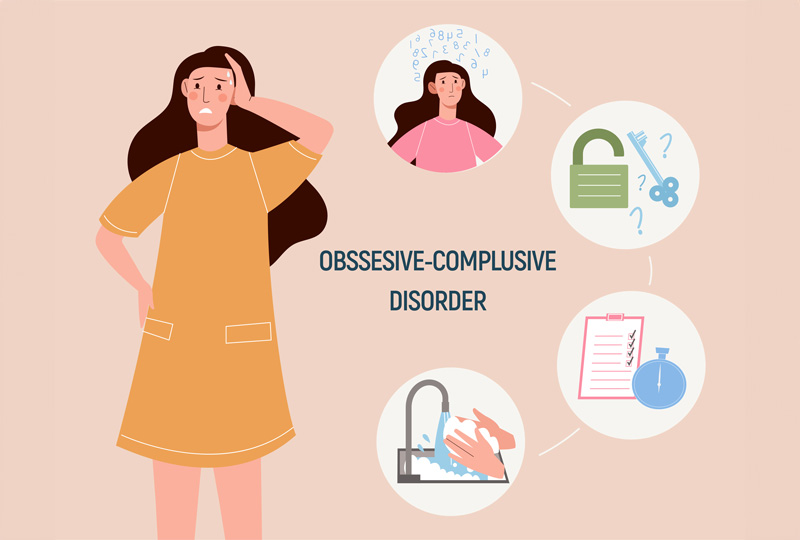Obsessive compulsive disorder or OCD is a mental health diagnosis that is sometimes casually referenced in everyday conversation and, unfortunately, may be commonly misunderstood as a result. For example, you might’ve heard someone say, “I’m so OCD,” and identify themselves in this way because they consider themselves a “neat freak” or prefer that they are clean and organized. As a result, people may mistake OCD as primarily being associated with people who like to be tidy or those who are “germophobes” and like to wash their hands. While an individual with diagnosable obsessive compulsive disorder (OCD) can have contamination-related concerns or feel the need to order/arrange items in a particular way, OCD is not limited to these areas. It’s also important to note that just because someone prefers cleanliness or organization doesn’t mean they have OCD. Various characteristics are associated with OCD and distinguish it from the personal preferences some of us may have.

So, what is OCD, then? Obsessive compulsive disorder or OCD is a mental health condition that can impact individuals across all ages and backgrounds (i.e., SES levels, race/ethnicities, gender, etc.). The National Institute of Mental Health indicates that about 1.2% of adults in the US are affected by OCD, and those impacted can experience its onset at any time. OCD is characterized by the interaction of two parts – obsessions and compulsions. Obsessions are unwanted thoughts, urges, or images that repeatedly enter one’s mind and result in unpleasant feelings for an individual, such as extreme fear, distress, or disgust. Due to the extreme discomfort experienced from the obsessions, an individual will often feel compelled to engage in compulsions. Compulsions (also known as ‘rituals’) can be in the form of repetitive behaviors (which can include avoidance) and/or mental actions that often alleviate the unpleasant feelings from the obsessions in the short-term. Given that an individual’s compulsions can be in the form of mental compulsions, one’s compulsions may not always be observable. Due to the temporary relief that compulsions can provide, an individual will usually continue to engage in compulsions any time obsessions enter their mind; in turn, this combination of ongoing obsessions and compulsions can result in getting caught in the “OCD cycle.”
So, what does all of this mean, and how can OCD present in someone’s life? When it comes to OCD, anything goes, meaning a person can have obsessions or unwanted thoughts/urges/images about any content. Some of the common obsessions that occur in OCD can include but are not limited to obsessions related to contamination, harm to self or others, religious/moral concerns, sexual obsessions, a need for ordering/arranging/symmetry, and perfectionism. For example, an individual with a harm obsession may have unwanted thoughts of handling sharp objects and may fear accidentally hurting someone; some examples of compulsions that the individual may then feel driven to engage in to alleviate their distress could include avoidant behavior and removing all sharp objects, such as knives, from one’s possession or reviewing over and over mentally in their mind if there was blood or injury to anyone when holding a sharp object. A person with a sexual obsession may have unwanted images that come to mind related to sexual behavior with friends or strangers; a compulsion could include seeking reassurance from others that they didn’t look at them or inappropriately touch them. Someone else’s OCD may involve experiencing an unwanted urge involving the need to rewrite until their penmanship is perfect, is precisely on the lines, and the letters are evenly spaced apart; the compulsion would then be rewriting and positioning their letters in a particular way. For some, an individual’s obsessions and compulsions can seem unrelated to one another. For example, a person may have obsessions related to something terrible happening to their family if they don’t re-read every line in a book at least five times; in this case, the compulsion would involve re-reading despite it seeming disconnected from the obsession.
Just as the content of obsessions can be vast, there are a variety of compulsions that people can engage in. Common compulsions include but are not limited to washing/cleaning (e.g., excessive showering, excessive cleaning of items), checking (e.g., excessive checking of locks, excessive checking of kitchen appliances being turned off), repeating tasks (e.g., re-reading, going in and out of a doorway), seeking reassurance (e.g., asking others that the feared outcome didn’t occur), counting/re-counting (e.g., counting objects such as books in a bookcase, counting when you repeat certain activities like washing), and mental compulsions (e.g., mentally reviewing or replaying in one’s mind that the feared outcome didn’t come true, such as accidentally harming others).
OCD often involves an individual experiencing doubt at the core of the condition; therefore, the compulsions may serve as a way to re-gain certainty and reduce the likelihood in the individual’s mind that their obsession comes true (e.g., accidentally harming others, engaging in unwanted sexual behavior with one’s friends, an unfortunate event happening to one’s family). In these various examples, the person gets caught in the OCD cycle when they repeatedly engage in their compulsions in response to their re-occurring obsessions.
It’s essential to keep in mind that individuals with OCD do not want to have their obsessions, and they find them highly distressing. In the aforementioned examples, one does not want to hurt others with sharp objects or engage in sexual behaviors with friends and strangers. The term ‘obsession’ in the context of Obsessive Compulsive Disorder is significantly different than how we may typically view the word when we talk about a person being obsessed or having an obsession for something (e.g., someone may be obsessed with watching crime shows). In this context, the obsession is a favorable preference for a genre of TV; however, an individual with OCD does not have a liking for their obsession, but rather, it’s perceived as intrusive.
The compulsions or rituals in OCD should also be made distinct from commonly known repetitive behaviors people may engage in, such as collecting items like baseball cards, engaging in religious rituals, daily routines, or game-day rituals for sporting events; most often, these forms of rituals are usually desirable to perform. Similarly to obsessions, individuals with OCD do not necessarily want to engage in their compulsions but rather feel the need to perform their compulsions out of an intense urge, fear, or discomfort from their obsessions.
Many of us have likely had an obsession or engaged in a compulsion at some point, as occasional intrusive thoughts are considered to be a common human phenomenon. However, this in itself doesn’t qualify as someone having OCD. Instead, it’s the re-occurring and unwanted nature of obsessions and compulsions, along with the accompanying distress, that can differentiate those impacted by OCD. Because of this, additional characteristics of OCD may include the obsessions and compulsions occupying more of a person’s time than desired and may be time-consuming (usually, the threshold is about an hour per day). Due to the distressful, time-consuming aspect of the condition or the specific nature of one’s obsessions/compulsions, a person may also find that their OCD interferes with their daily life, such as getting in the way of their performance at school/work, preventing them from engaging in their daily activities and what’s important to them, or causing difficulties in their relationships.
OCD can be a problematic condition for individuals to experience and manage. However, it doesn’t need to be addressed alone. Fortunately, evidence-based or scientifically proven and effective treatment options are available for those impacted. In pursuing a mental health therapist, you may be able to understand the nature of your OCD symptoms better and gain the tools to address them.
Hongmarie Martinez, PsyD, is a licensed psychologist in New Jersey and New York and a certified school psychologist in New Jersey. She works at Behavior Therapy Associates in Somerset, New Jersey. Dr. Martinez has the authority from the PSYPACT commission to practice inter-jurisdictional telepsychology (APIT), allowing her to provide telepsychology to clients in many states. She can be reached at hmartinez@BehaviorTherapyAssociates.com and www.BehaviorTherapyAssociates.com.





